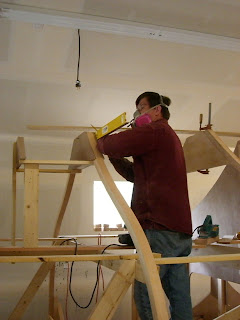
The rabbet/keel offsets were marked on the frames.

After each floor was marked it needed to be leveled and shaped by sanding (faired) to exact height.
Notice the use of the particulate respirator while sanding....

And the appropriate "ladder".....

Not wife approved.......

But "one out of two" safety precautions is better than none. There was some issue of "ladders just not fitting in among the supports" anymore.


A temporary board shows the shape of the keel for fairing.


Quarters are tight, looking from the spraybooth area of the cabinet shop, past the folded lofting table, through the "boat room", toward the true garage.

The port side is pretty tight. Richard is not looking forward to squeezing back there to do the planking....

The transom is in position. Almost all of the beautiful transom is above water line. The placement of the 60 degree angled transom took quite a bit of head scratching and manipulation. The off sets that were plotted needed to be considered with the angle of the transom. The vertical placement and angle were scaled off the drawings.

Its difficult to envision the shape with a full thickness of keel and after planking. Lots of compound sweeps and curves.

Richard placed an extra laminated frame inside the transom to give a wider area to fair across and assist with supporting planking to the transom.
The next step was notching for the sheer. The sheer is basically the line of the boat deck as seen from the side. It is incredibly important in the overall look and feel of the boat. A nicely sweeping sheer helps with the look of a classic boat. Mostly all that can be done upside down and in tight quarters is to scale and measure from DWL to the sheer and get as much curve to it as a board (the sheer clamp) will bend. The bulkheads and frames were notched to accept the sheer clamp.

The batten running the length of the hull near the strongback shows the sheer.
For the next 100 hours Richard got to get very tired of fairing the hull. Fairing is done to bevel and smooth the shape of the frames and bulkheads to flow with the strips that will be epoxied to them. A batten is laid across the frames in a smooth line from stem to stern. All extra wood (high spots) are shaved away with the use of planes or a rasp. This is a very labor intensive and tedious process, but will effect the ease and solidity of the planking. The batten is moved around the hull in different positions, and a fair hull in which planking could be applied in most directions is produced.
0 komentar:
Posting Komentar